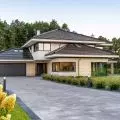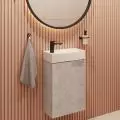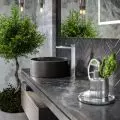concrete
When it comes to prefabrication in construction, it is impossible to forget concrete. Precast concrete products are widely known. Unfortunately, they are still associated by some with the great slab of the 1970s and 1980s. Modern technology, however, apart from the material and, of course, production in a factory, has little in common with the large slab blocks of the last century. The manufacturer of modern prefabricated reinforced concrete houses is the MABUDO company. Prefabricated, large elements arrive at the project site and are assembled by crane. The structural elements are two-layer reinforced concrete walls of the MABUDO ECO® type, three-layer walls of the MABUDO ROBUST® type, as well as wooden ceilings, filigree, and a prefabricated roof truss. Walls are made in a three-layer version - with thermal insulation between two layers of reinforced concrete, or a two-layer version - MABUDO ECO® - with thermal insulation on the room side. The technology allows you to build an energy-efficient house, with a heat transfer coefficient that meets the standards for this type of construction.
A house in the type of modern barn built using precast concrete technology; the choice of technology does not limit what material will be on the facade
Photo: © MABUDO
It is estimated that, for a house of about 150 square meters, it takes about two weeks to bring the house to the open shell state (preparing the foundations, putting up the walls and trusses). Another two are needed to close the shell state. On the other hand, the manufacturer needs about four months for the developer's state. The cost of construction depends, of course, on the complexity of the form of the house, the area and many other factors, while it can be assumed that in the case of a 150-square-meter house, we will pay from 5,000 zlotys per square meter for the developer's state. The speed of implementation and high quality of buildings make the interest in the technology grow - both among individual customers and developers.
A modern barn-type house built using precast concrete technology; the choice of technology does not limit what material will be used on the facade
Photo: © MABUDO
Considering concrete technologies, it is worth looking at the possibilities of 3D printing. In Poland, tests and prototypes of such realizations are made by REbuild, a company that works with 3DCP (3D construction/concrete printing) technology. It produces landscaping elements from concrete mix, but in 2018 it printed the first 7-square-meter room in the hall. Since then, REbuild engineers have been developing methods and equipment to print larger objects. So far, a technical building has been created for a restaurant in Wyszków, as well as minidomes for private customers. They plan to develop the technology to produce single-family homes or semi-detached houses. REbuild envisions three models for the production of houses: on-site or in the hall - either in their entirety (smaller structures) or by printing elements-modules that can be assembled.
How are the walls reinforced? For the time being, the laying of the reinforcement is done by an employee, who lays steel, basalt or glass rods in the appropriate places according to technical drawings. However, the company has already patented a process for automatic reinforcement - an engineered head lays fiberglass soaked in resin, and in this way a structural reinforcement is created. This solution is still in the laboratory testing phase. In addition, polypropylene fibers are placed in the concrete mix to strengthen the concrete and avoid cracks.
The issue of thermal insulation is solved in a similar way as with other large-plate technologies, that is, in the next stage of building construction. Insulation can be added to the structure for both two- and three-layer walls. Plumbing, on the other hand, can be run on top or in the gap between the layers (in the case of a three-layer wall). Electrical boxes can be added during the printout or only marked where they occur, saving time and avoiding errors.
Trials and experiments on printing concrete buildings on a 3D printer are being undertaken by REbuild; the technology is still being improved, including process automation, refinement of the concrete mix or wall texture effects
Photo: © REbuild
expanded clay
Another available large-slab solution is precast expanded clay. Expanded clay is a porous material - it is, in short, a large-format ceramic that is characterized by moisture resistance and non-combustibility. Lightweight expanded concrete also has relatively good acoustic properties. The finished floor-height structural elements are brought to the site and assembled by crane on a pre-prepared foundation slab. It takes about one day to install the walls of one story. For example, the houses offered by Abakon have an exterior structure 15 centimeters thick, and the partition walls - 10. The exterior partitions require additional insulation and finishing, while on the interior a smooth finish is sufficient. What is the price of a prefabricated expanded clay house? "Taking into account the structural diversity and dependencies related to the scope of work for different types of buildings, the price lists of workmanship will vary. Of course, during the process of agreement with the investor, there may be additional elements that affect the final price of implementation. Assuming a full developer's state including the foundation, the realization price for buildings with an attic starts from about 3950 PLN gross per square meter of building area," he says. - says Marcin Szeliga of Abakon.
The walls of a house made of prefabricated expanded clay are built quickly - on the construction site the walls are assembled from ready-made elements
photo: © Abakon
straw
A completely different, because typically natural, technology is wood-straw modules, the so-called strawbale. The structure of the building is formed by walls of wooden-framed modules, filled with compacted straw. The individual elements of the walls are prepared at the factory and assembled at the project site. It usually takes about a week to erect the walls on the prepared foundation slab. Michal Koziej, an architect working with EcoCocon, a manufacturer of modular straw walls, notes, "There is a global shift toward healthier, more sustainable and energy-efficient housing. Bio-based building materials such as straw and wood are experiencing a renaissance after a pandemic period in which people have realized the importance of indoor quality. They will also play a key role in reducing the carbon footprint of the construction industry and meeting climate targets set by governments across the EU." How popular are the panels from EcoCocon? The architect admits that walls were created for 67 projects in Europe last year. Although the manufacturer does not provide a comprehensive home construction service, it has cooperating contractors. It is estimated that for a square meter of the surface of a one-hundred-and-fifty-meter house in developer condition we will pay about 5500 zlotys net (of which about 15-20 percent will be the cost of walls).
Ecomodus panels and a house built using strawbale technology; houses built using this method are valued for their energy efficiency, quick construction time, use of renewable, biodegradable materials and optimal, healthy environment inside the building.
Photo: © Ecomodus
Dr. Michal Wojcicki, a popularizer of natural building knowledge and owner of Ecomodus, points to lower costs and fast construction time: "First of all, Ecomodus straw panels are cheaper than building a wall using masonry technology. The customer receives ready-made, manufactured wall and roof elements. The prefabrication process largely eliminates the human factor in the process of building a house, and as is known, it often generates basic problems on the construction site. In addition to the financial benefit, the customer will appreciate the rapid production and assembly time of the house, which, with proper planning, we can minimize to three months. The assembly of the shell of a house with a construction area of 150 square meters does not exceed a week." What else are the advantages of this technology? In the interiors, clay plaster is often used, which allows to maintain an optimal microclimate in the house and at the same time does not produce volatile organic compounds (VOCs). The walls have good vapor barrier and acoustic properties. With straw and wood, there may be a question about fire resistance, but the very strong compression of straw makes it very difficult to ignite the structure. In addition, when plastered, the panels can meet REI 120 and REIef120 standards.
Despite the many technological possibilities, when it comes to advantages, manufacturers of prefabricated houses tend to agree - the most important thing is the speed of implementation. In some variants it is impressive - the house simply appears on the plot and its installation takes one day. And even, as in other cases, when the main structure is built several days or a week, it is still very impressive.
Another advantage in choosing a house from the factory is complexity. Investors' involvement is minimized, and the burden of construction and the many problems that this process can generate is on the manufacturer's side. Less time and stress spent on seeing to the construction is definitely a more convenient option. It is also important to note that in a large part of cases when choosing prefabricated technology, the overall cost of the investment is known from the beginning. In the case of traditional construction - investors, when starting construction, are often not aware of all the costs they will have to incur. They know them in an estimated way, plan to save on individual stages, and this is done with varying results. Changing prices of construction materials during a drawn-out implementation can also mess up the overall cost.
The quality of the building is also not insignificant - specialists are responsible for the production and assembly of prefabricated elements. They take care of the connections of individual elements to avoid leaks or thermal bridges. In the case of a comprehensive service, there is no possibility to blame workmanship errors on other teams, so the houses are warm and solid.
Ecomodus panels and a house built using strawbale technology; houses built using this method are valued for their energy efficiency, quick construction time, use of renewable, biodegradable materials, and optimal, healthy indoor environment
Photo: © EcoCocon
Very often, manufacturers mention investor awareness - both in terms of the choice of a specific technology and the desire to avoid the inconvenience of the construction process. Environmental issues are also important for investors. Some choose a house made of natural or renewable materials, such as wood or straw. But the very fact of prefabrication means that - regardless of the chosen technology - there is less waste, unused materials and thus - less harm to the planet.
Given the enormity of the possibilities available in prefabricated construction, it seems surprising that most houses in Poland are built using traditional technologies. Is this due to fear of something new? It's possible, but many of the technologies described above, such as timber-frame construction, are quite popular in other parts of the world, sometimes even the most popular construction methods. Perhaps the problem is the difficulty in finding contractors? Many companies handle the service comprehensively, some have many years of experience, so this argument can be refuted as well.
Maybe it's all about money? The fact is that knowing the total cost at the start of construction can be frightening, and many investors may assume that by taking care of everything on their own they will "manage cheaper." To address this, it would be necessary to compare in detail the cost of construction with different technologies in a specific location.
So, does a future with factory-built homes await us? Both yes and no. I think that prefabricated houses will appear more and more in our landscape. However, I don't think they will completely displace traditional technologies. For that to happen, a huge change would be needed both in the education of potential investors and in the training of architects or civil engineers. Nevertheless, I believe that the popularization of prefabricated technologies is absolutely the right thing to do.



























































